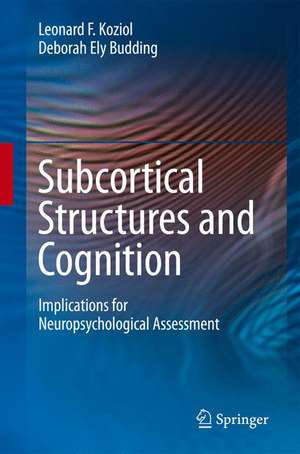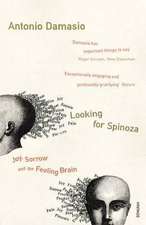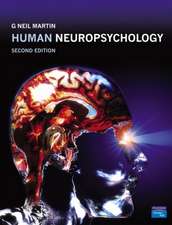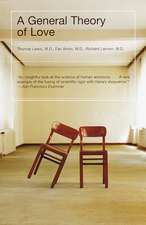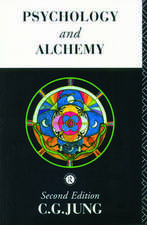Subcortical Structures and Cognition: Implications for Neuropsychological Assessment
Autor Leonard F. Koziol, Deborah Ely Buddingen Limba Engleză Paperback – 14 mai 2010
The second half of the book examines neuropsychological assessment. Patients with lesions restricted to the cerebellum and/or basal ganglia have been described as exhibiting a variety of cognitive deficits on neuropsychological tests. Numerous investigations have demonstrated that higher-level cognitive functions such as attention, executive functioning, language, visuospatial processing, and learning and memory are affected by subcortical pathologies. There is also considerable evidence that the basal ganglia and cerebellum play a critical role in the regulation of affect and emotion. These brain regions are an integral part of the brain’s executive system. The ability to apply new methodologies clinically is essential in the evaluation of disorders with subcortical pathology, including various developmental disorders (broadly defined to include learning disorders and certain psychiatric conditions), for the purpose of gaining greater understanding of these conditions and developing appropriate methodologies for treatment.
The book is organized around three sources of evidence:
- neuroanatomical connections;
- patients with various disease processes;
- experimental studies, including various imaging techniques.
Cognitive neuroscience is entering a new era as we recognize the roles of subcortical structures in the modulation of cognition. The fields of neuropsychology, cognitive psychology, neuropsychiatry, and neurology are all developing in the direction of understanding the roles of subcortical structures in behavior. This book is informative while defining the need and direction for new paradigms and methodologies for neuropsychological assessment.
| Toate formatele și edițiile | Preț | Express |
|---|---|---|
| Paperback (1) | 1029.34 lei 6-8 săpt. | |
| Springer – 14 mai 2010 | 1029.34 lei 6-8 săpt. | |
| Hardback (1) | 1042.90 lei 6-8 săpt. | |
| Springer – 2 dec 2008 | 1042.90 lei 6-8 săpt. |
Preț: 1029.34 lei
Preț vechi: 1255.29 lei
-18% Nou
Puncte Express: 1544
Preț estimativ în valută:
196.99€ • 203.50$ • 163.94£
196.99€ • 203.50$ • 163.94£
Carte tipărită la comandă
Livrare economică 25 martie-08 aprilie
Preluare comenzi: 021 569.72.76
Specificații
ISBN-13: 9780387848679
ISBN-10: 0387848673
Pagini: 405
Ilustrații: XIII, 405 p. 19 illus., 10 illus. in color.
Dimensiuni: 155 x 235 x 25 mm
Greutate: 1.29 kg
Ediția:2009
Editura: Springer
Colecția Springer
Locul publicării:New York, NY, United States
ISBN-10: 0387848673
Pagini: 405
Ilustrații: XIII, 405 p. 19 illus., 10 illus. in color.
Dimensiuni: 155 x 235 x 25 mm
Greutate: 1.29 kg
Ediția:2009
Editura: Springer
Colecția Springer
Locul publicării:New York, NY, United States
Public țintă
ResearchDescriere
Clinical psychologists and neuropsychologists are traditionally taught that cognition is mediated by the cortex and that subcortical brain regions mediate the coordination of movement. However, this argument can easily be challenged based upon the anatomic organization of the brain. The relationship between the prefrontal cortex/frontal lobes and basal ganglia is characterized by loops from these anterior brain regions to the striatum, the globus pallidus, and the thalamus, and then back to the frontal cortex. There is also a cerebrocerebellar system defined by projections from the cerebral cortex to the pontine nuclei, to the cerebellar cortex and deep cerebellar nuclei, to the red nucleus and then back to thalamus and cerebral cortex, including all regions of the frontal lobes. Therefore, both the cortical-striatal and cortical-cerebellar projections are anatomically defined as re-entrant systems that are obviously in a position to influence not only motor behavior, but also cognition and affect. This represents overwhelming evidence based upon neuroanatomy alone that subcortical regions play a role in cognition. The first half of this book defines the functional neuroanatomy of cortical-subcortical circuitries and establishes that since structure is related to function, what the basal ganglia and cerebellum do for movement they also do for cognition and emotion.
The second half of the book examines neuropsychological assessment. Patients with lesions restricted to the cerebellum and/or basal ganglia have been described as exhibiting a variety of cognitive deficits on neuropsychological tests. Numerous investigations have demonstrated that higher-level cognitive functions such as attention, executive functioning, language, visuospatial processing, and learning and memory are affected by subcortical pathologies. There is also considerable evidence that the basal ganglia and cerebellum play a critical role in the regulation of affect and emotion. These brain regions are an integral part of the brain’s executive system. The ability to apply new methodologies clinically is essential in the evaluation of disorders with subcortical pathology, including various developmental disorders (broadly defined to include learning disorders and certain psychiatric conditions), for the purpose of gaining greater understanding of these conditions and developing appropriate methodologies for treatment.
The book is organized around three sources of evidence:
Cognitive neuroscience is entering a new era as we recognize the roles of subcortical structures in the modulation of cognition. The fields of neuropsychology, cognitive psychology, neuropsychiatry, and neurology are all developing in the direction of understanding the roles of subcortical structures in behavior. This book is informative while defining the need and direction for new paradigms and methodologies for neuropsychological assessment.
The second half of the book examines neuropsychological assessment. Patients with lesions restricted to the cerebellum and/or basal ganglia have been described as exhibiting a variety of cognitive deficits on neuropsychological tests. Numerous investigations have demonstrated that higher-level cognitive functions such as attention, executive functioning, language, visuospatial processing, and learning and memory are affected by subcortical pathologies. There is also considerable evidence that the basal ganglia and cerebellum play a critical role in the regulation of affect and emotion. These brain regions are an integral part of the brain’s executive system. The ability to apply new methodologies clinically is essential in the evaluation of disorders with subcortical pathology, including various developmental disorders (broadly defined to include learning disorders and certain psychiatric conditions), for the purpose of gaining greater understanding of these conditions and developing appropriate methodologies for treatment.
The book is organized around three sources of evidence:
- neuroanatomical connections;
- patients with various disease processes;
- experimental studies, including various imaging techniques.
Cognitive neuroscience is entering a new era as we recognize the roles of subcortical structures in the modulation of cognition. The fields of neuropsychology, cognitive psychology, neuropsychiatry, and neurology are all developing in the direction of understanding the roles of subcortical structures in behavior. This book is informative while defining the need and direction for new paradigms and methodologies for neuropsychological assessment.
Cuprins
Introduction: Movement, Cognition, and the Vertically Organized Brain.- The Basal Ganglia: Beyond the Motor System—From Movement to Thought.- Frontal–Subcortical Real Estate: Location, Location, Location.- Learning and the Basal Ganglia: Benefiting from Action and Reinforcement.- The Cerebellum: Quality Control, Creativity, Intuition, and Unconscious Working Memory.- Automaticity and Higher-Order Control in Communication: A Brief Introduction to Language and Social Cognition.- The Vertically Organized Brain in Clinical Psychiatric Disorders.- Familiarity and Novelty—Evaluating the Frontostriatal System.- Thought in Action: Procedural Learning, Processing Speed, and Automaticity.- The Basal Ganglia and Neuropsychological Testing.- The Cerebellum in Neuropsychological Testing.- The Integrated Brain: Implications for Neuropsychological Evaluation.
Recenzii
From the reviews: "Given its broad coverage and the clarity of writing, it should be very valuable for graduate students and in courses. This book opens the door to creativity by inviting neuropsychologists to develop new methodologies of investigations, following the demonstration that the cortico-centric model of cognition is no longer tenable. The authors have made a great job in bringing complex issues into simple and meaningful lines." (M.-U. Manto, The Cerebellum, Published online: 10 September 2009) "Drs. Koziol and Budding have written a highly readable and thought-provoking book that will challenge the reader’s current knowledge and help one to look beneath the surface. It is a must read for … neuropsychologist and should be on the reading list for every neuropsychology graduate student. … It is interesting to ponder … if this text becomes a standard in the neuropsychological training curriculum. … this book will assuredly give the reader a ‘deeper’ understanding of the brain." (William S. MacAllister, The Clinical Neuropsychologist , Issue 1-3, 2009) "This is a fine summary of a great deal of literature on the basal ganglia and cerebellum and of their intimate relationships with the cortical forebrain. ... This book applies a long overdue corrective to a discipline that in some sense has been blinded by the simplistic corticocentric view of brain function. If the book prompts neuropsychologists to read outside their traditionally rather constricted domains (the neuropsychological testing literature) and to more fully explore other domains of neuroscience, it will have performed a double service. I recommend it highly." (Douglas F. Watt, Harvard Medical School, Archives of Clinical Neuropsychology 25 (2010) 153–155)
Notă biografică
Dr. Leonard F. Koziol is a clinical psychologist with specialty board certifications in Neuropsychology and Pediatric Neuropsychology. He works with children, adolescents, and adults with attention or concentration problems, memory loss, or learning disabilities. Dr. Koziol has served as a forensic psychologist expert in legal proceedings. Dr. Koziol is currently part of the Clinical Faculty at Chicago Medical School, Finch University Hospital Clinic, North Chicago, IL; the Consulting Neuropsychology Faculty at Fielding Institute, Santa Barbara, CA; and the Adult Faculty at Illinois School of Professional Psychology, IL, from where he is also a Professional Psychology graduate. His awards include: Fellow, National Academy of Neuropsychology – 2004; and Fellow, American College of Professional Neuropsychology – 1995.
Deborah Ely Budding is a clinical neuropsychologist practicing in Southern California. She worked as a writer and editor prior to training as a psychologist and neuropsychologist. She specializes in evaluating children, adolescents and adults with neurodevelopmental disorders and has a particular interest in integrating emotional and cognitive, as well as conscious and unconscious aspects of function. She holds specialty board certifications in Neuropsychologyand Pediatric Neuropsychology.
Deborah Ely Budding is a clinical neuropsychologist practicing in Southern California. She worked as a writer and editor prior to training as a psychologist and neuropsychologist. She specializes in evaluating children, adolescents and adults with neurodevelopmental disorders and has a particular interest in integrating emotional and cognitive, as well as conscious and unconscious aspects of function. She holds specialty board certifications in Neuropsychologyand Pediatric Neuropsychology.
Textul de pe ultima copertă
Subcortical Structures and Cognition
Implications for Neuropsychological Assessment
Leonard F. Koziol, Private Practice, Arlington Heights, Illinois
Deborah Ely Budding, Private Practice, Manhattan Beach, California
The study of neuropsychology traditionally begins with geography: the neocortex as the seat of cognition and behavior, and the subcortical regions coordinating movement. Subcortical Structures and Cognition breaks with this traditional view, arguing for a practice-oriented rethinking of brain organization.
The authors’ structural/functional analysis redefines the cerebral hemispheres, basal ganglia, and cerebellum as operating in parallel to control cognition, affect, and behavior as well as movement. Case studies and empirical data flesh out this intricate scenario, linking pathology in subcortical structures with psychiatric, learning, and developmental disabilities. These findings are at the forefront of clinical research, significant not only in theoretical terms but also leading to new advances in testing, assessment, and treatment.
Highlights of the book:
Implications for Neuropsychological Assessment
Leonard F. Koziol, Private Practice, Arlington Heights, Illinois
Deborah Ely Budding, Private Practice, Manhattan Beach, California
The study of neuropsychology traditionally begins with geography: the neocortex as the seat of cognition and behavior, and the subcortical regions coordinating movement. Subcortical Structures and Cognition breaks with this traditional view, arguing for a practice-oriented rethinking of brain organization.
The authors’ structural/functional analysis redefines the cerebral hemispheres, basal ganglia, and cerebellum as operating in parallel to control cognition, affect, and behavior as well as movement. Case studies and empirical data flesh out this intricate scenario, linking pathology in subcortical structures with psychiatric, learning, and developmental disabilities. These findings are at the forefront of clinical research, significant not only in theoretical terms but also leading to new advances in testing, assessment, and treatment.
Highlights of the book:
- The shift from cortex-centered to cortical-subcortical neuropsychology.
- Functional anatomy of the cerebellum and basal ganglia, and their roles in cognition, emotion, and behavior.
- The neuroanatomy of experiential and reinforcement-based learning.
- Review of cognition as an extension of the motor control system.
- Cases illustrating the relationships between cortical and subcortical systems in various types of pathology.
- The current state of neuropsychological assessment.
- Results of experimental studies, including imaging technologies.
- Future directions for neuropsychology, neurology, and related fields.
Caracteristici
There are no other books available that discuss the cognitive and emotional aspects of subcortical pathology at the level of clinical neuropsychology
At the cutting edge of clinical research connecting subcortical processes to cognition and affect
At the cutting edge of clinical research connecting subcortical processes to cognition and affect
